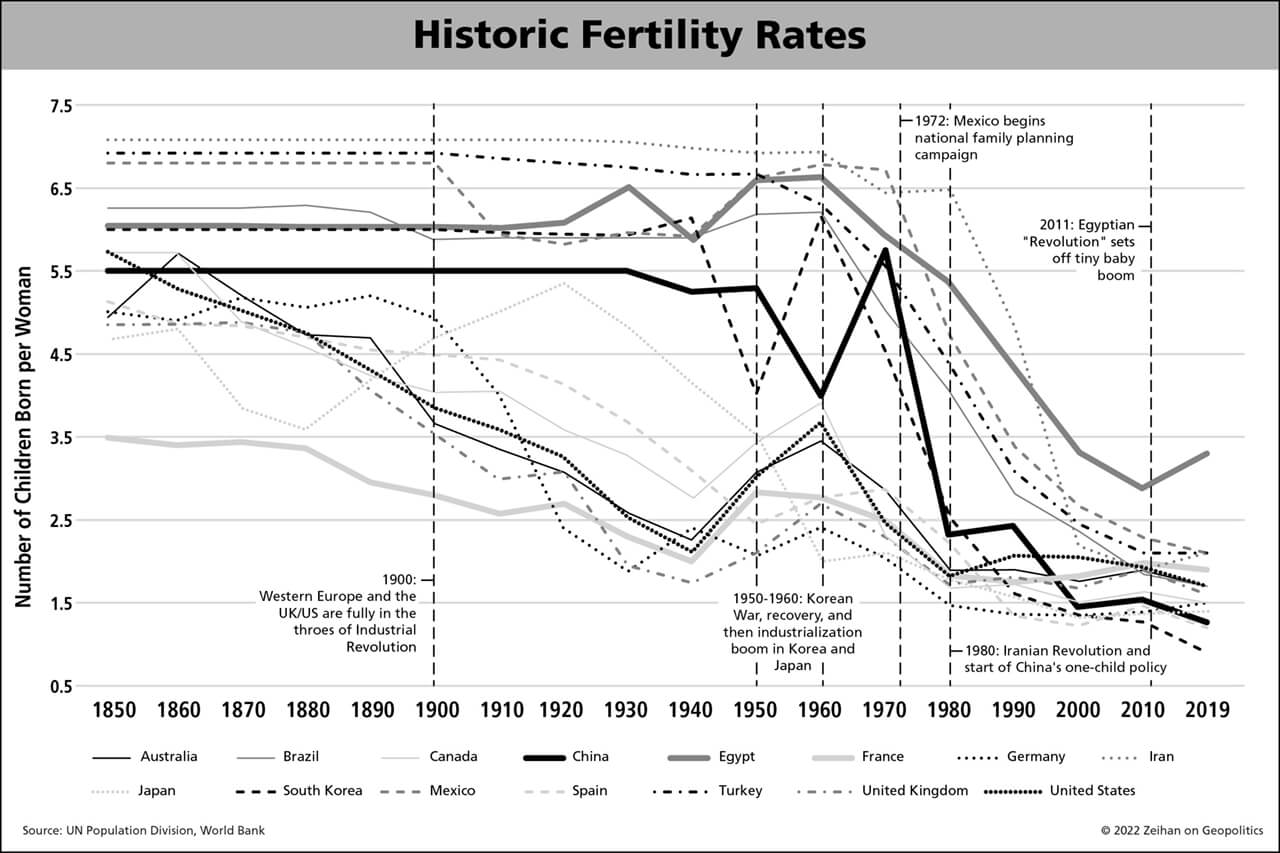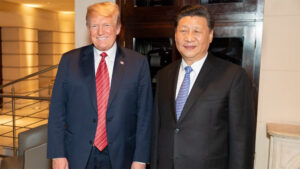My fourth book, The End of the World Is Just the Beginning: Mapping the Collapse of Globalization is scheduled for release on June 14. In coming weeks we will be sharing graphics and excerpts, along with info on how to preorder.
Demography forms one of the cornerstones of how we look at the world. Geopolitics means a lot of things depending on who you ask, but for myself and my team geopolitics at its core is the synthesis of the study of geography, demographics, and economy. That’s not to say things like military prowess, agricultural capability, and more aren’t important. But they’re secondary, in that they are shaped by factors like the quality of arable land and the amount of people you can put into factories or militaries or sell goods to.
Enter this graphic from my upcoming book, The End of the World is Just the Beginning. We have a visual comparison of various historic birth rates for the last 170 years or so. Rises in birthrates, like for the US and Australia through in the 50s and early 60s correspond with the post-war Baby Boom. This is the last peak for most developed countries, who all saw a decline in the number of children born per woman as their respective industrial revolutions took hold and a rural-to-urban societal shift took place.
There are a couple broad trends to note: birthrates across the world–regardless of culture, religion, per capita GDP–have experienced a precipitous decline in recent decades. Egypt is an outlier, as are countries who have accepted significant numbers of immigrants/refugees relative to their population like Germany, Turkey, and Iran.
But the starkest decline is the thick, unbroken line in black. That’s China, and it’s bad.
We’ve had indications for a while now that China was already one of the fastest-aging populations in the world. But with recent revisions of their population data coming to light last year we know that not only are they perhaps the fastest aging population in the world, their birthrate is one of the lowest. Only Spain’s and South Korea’s are lower–and just barely.
When we talk about themes like The End of More in the book, we discuss how the Bretton Woods system allowed countries without the demographic wealth of pre-industrial China to use CCP-subsidized labor as part of globe-spanning supply chains. Chinese labor costs have increased handily in the last decade or two, but there’s more to the Chinese ticking demographic bomb than rising labor costs. China’s population is aging, and elderly people need more capital and labor for their care than young people. They consume less. They produce less. China is going to need more money to care for a growing segment of its population that is increasingly dependent on the state, with less young people to produce and consume the goods manufacturing that is the bedrock of the Chinese economy. Failing to do so would be untenable in any Confucian society that reveres its elders. For a China whose ruling Communist Party’s legitimacy is anchored to upholding a social welfare contract, failure is suicidal.
Which still says nothing about a global manufacturing economy that since the end of the Cold War has had one foot planted firmly in China.

Here at Zeihan On Geopolitics we select a single charity to sponsor. We have two criteria:
First, we look across the world and use our skill sets to identify where the needs are most acute. Second, we look for an institution with preexisting networks for both materials gathering and aid distribution. That way we know every cent of our donation is not simply going directly to where help is needed most, but our donations serve as a force multiplier for a system already in existence. Then we give what we can.
Today, our chosen charity is a group called Medshare, which provides emergency medical services to communities in need, with a very heavy emphasis on locations facing acute crises. Medshare operates right in the thick of it. Until future notice, every cent we earn from every book we sell in every format through every retailer is going to Medshare’s Ukraine fund.
And then there’s you.
Our newsletters and videologues are not only free, they will always be free. We also will never share your contact information with anyone. All we ask is that if you find one of our releases in any way useful, that you make a donation to Medshare. Over one third of Ukraine’s pre-war population has either been forced from their homes, kidnapped and shipped to Russia, or is trying to survive in occupied lands. This is our way to help who we can. Please, join us.








